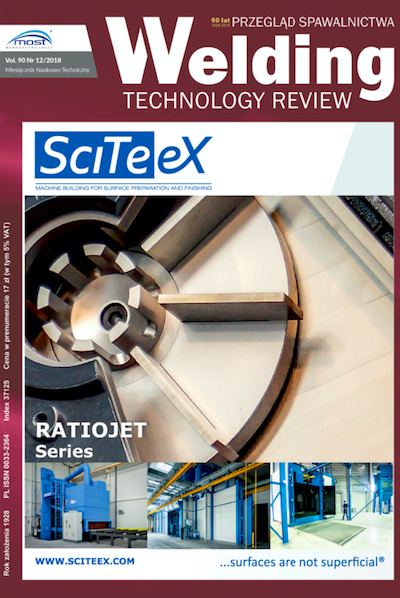Causes of cracks of chemical apparatus made of austenitic steel
Main Article Content
Abstract
The subject of the research was the installation of a water steam used in the chemical industry. Penetration tests revealed an extensive network of cracks on the surface of steel and welds. Metallographic studies, chemical composition analysis, EDX anal-ysis were performed. Thermal treatment of steel was carried out and microhardness measurements were made. The results of the tests showed that stress corrosion was the main reason for the occurrence of cracks.
Downloads
Article Details
Creative Commons CC BY 4.0 https://creativecommons.org/licenses/by/4.0/
Welding Technology Review (WTR) articles are published open access under a CC BY licence (Creative Commons Attribution 4.0 International licence). The CC BY licence is the most open licence available and considered the industry 'gold standard' for open access; it is also preferred by many funders. This licence allows readers to copy and redistribute the material in any medium or format, and to alter, transform, or build upon the material, including for commercial use, providing the original author is credited.
References
G. R. Mirshekari, E. Tavakoli, M. Atapour, B. Sadeghian, Microstructure and corrosion behavior of multipass gas tungsten arc welded 304L stainless steel, Materials and Design (2014), 55, 905-911. DOI: https://doi.org/10.1016/j.matdes.2013.10.064
A. Świerczyńska, G. Rogalski, D. Fydrych, Badania struktury i właściwości spawanych austenitycznych rur wymienników ciepła, Welding Technolo- gy Review (2010), vol. 82 (6), 11-16.
K.R.M. Rao, S. Mukherjee, P.M. Raole, I. Manna, Characterization of surface microstructure and properties of low-energy high-dose plasma immersion ion-implanted 304L austenitic stainless steel, Surface and Coating Technology (2005), 200, 2049-2057. DOI: https://doi.org/10.1016/j.surfcoat.2004.06.035
S. Ghosh, V. P. S. Rana, V. Kain, V. Mittal, S.K. Baveja, Role of residual stresses induced by industrial fabrication on stress corrosion cracking susceptibility of austenitic stainless steel Materials & Design (2011), vol. 32 (7), 3823-3831.
E. Tasak, A. Ziewiec, Spawalność materiałów konstrukcyjnych, Wydawnictwo JAK, Kraków (2009).
H. Ezuber, A. Alshater, S. O. Nisar, A. Gonsalvez, S. Aslam, Effect of Surface Finish on the Pitting Corrosion Behavior of Sensitized AISI 304 Austenitic Stainless Steel Alloys in 3.5% NaCl Solutions, Surface Engineering and Applied Electrochemistry (2018), 54, 73-80 DOI: https://doi.org/10.3103/S1068375518010039
R. E. Melchers, I. A. Chaves, R. Jeffrey, A Conceptual Model for the Interaction between Carbon Content and Manganese Sulphide Inclusions in the Short-Term Seawater Corrosion of Low Carbon Steel, Metals (2016), vol.6 (6), 132.
T. Prosek, A. Iversen, C. Taxn, D. Thierry, Low-Temperature Stress Corrosion Cracking of Stainless Steels in the Atmosphere in the Presence of Chloride Deposits, CORROSION (2009), vol. 65 (2), 105-117.
S. Ghos, , V. P. S. Rana, V. Kain, V. Mittal, S.K. Baveja, Role of residual stresses induced by industrial fabrication on stress corrosion cracking susceptibility of austenitic stainless steel, Materials and Design (2011), 32, 3823-3831. DOI: https://doi.org/10.1016/j.matdes.2011.03.012
P. Roffey, E. H. Davies, The generation of corrosion under insulation and stress corrosion cracking due to sulphide stress cracking in an austenitic stainless steel hydrocarbon gas pipeline, Engineering Failure Analysis (2014), 44, 148-157. DOI: https://doi.org/10.1016/j.engfailanal.2014.05.004
PN-H-86020:1971 Stal odporna na korozję (nierdzewna i kwasoodporna) Gatunki.
PN-EN 10028-7:2016-09 wyroby płaskie ze stali na urządzenia ciśnieniowe Część 7: Stale odporne na korozję
I.I. Vasilenko, R.K. Melehov, Korrozionnoe rastreskivanie stali, Kiev (1977) (ВаÑиленко И.И., Мелехов Ð .К.: Коррозионное раÑтреÑкивание Ñталей, Киев 1977).
G. Rogalski, J. Łabanowski, D. Fydrych, A. Świerczyńska, Wpływ obróbki cieplnej na właściwości spawanych austenitycznych rur wymienników ciepła, Welding Technology Review (2014), vol. 86 (6), 24-31.
